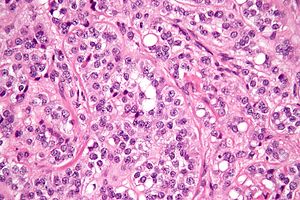支持细胞瘤
外观
(重定向自睾丸支持细胞瘤)
| 支持细胞瘤 | |
|---|---|
 | |
| 高度显微镜下的支持细胞瘤 | |
| 类型 | testicular sex cord-stromal neoplasm[*]、性腺间质肿瘤 |
| 分类和外部资源 | |
| 醫學專科 | 肿瘤学 |
| ICD-11 | XH4H24 |
| ICD-9-CM | 183.0, 256.1 |
| ICD-O | 8631 |
| MeSH | D012707 |
支持细胞瘤(英語:Sertoli cell tumour, Sertoli cell tumor),是一种隶属于卵巢肿瘤或睾丸肿瘤下的一类性索间质肿瘤,是由支持细胞病变引起。尽管支持细胞细胞通常在睾丸中[1],而此类病变在被发现于卵巢中[2]。
一类肿瘤同时产生病变的间质细胞和支持细胞的综合症,被称为支持间质细胞瘤。
诊断
[编辑]
由于肿瘤生成大量的雌性激素,1/3的女性患者都会有女性化的特征。卵巢肿瘤伴有内分泌紊乱情况下,会被诊断为间质细胞瘤、卵巢颗粒细胞瘤、或泡膜细胞瘤。最终诊断依赖于术中或术后组织学病理分析。
治疗
[编辑]常见的支持细胞瘤治疗方式是手术,通常是保留生育功能的单侧输卵管卵巢切除术。对于恶性肿瘤,需要采用更激进的手术策略,并通常使用辅助化学疗法,一些时候需要放射疗法。在所有治疗过程中,需要保持多次物理检查与成像监控,因为在很多病例中,支持细胞瘤并没有引起肿瘤标记数值的增加[3]。
预后效果通常很理想,肿瘤大多时候生长缓慢,而且是良性的。但对于恶性肿瘤的病例,因为其组织学不同,预后效果往往很差[3]。
支持细胞瘤也存在于其他物种中,包括家鸭[4]、狗类[5][6],和马类。
其他图像
[编辑]-
低密度显微镜下的支持细胞瘤
-
高密度显微镜下的支持细胞瘤
相关
[编辑]参考
[编辑]- ^ Young RH, Koelliker DD, Scully RE. Sertoli cell tumors of the testis, not otherwise specified: a clinicopathologic analysis of 60 cases. Am. J. Surg. Pathol. June 1998, 22 (6): 709–21 [2013-10-14]. PMID 9630178. doi:10.1097/00000478-199806000-00008. (原始内容存档于2012-05-05).
- ^ Oliva E, Alvarez T, Young RH. Sertoli cell tumors of the ovary: a clinicopathologic and immunohistochemical study of 54 cases. Am. J. Surg. Pathol. February 2005, 29 (2): 143–56 [2013-10-14]. PMID 15644771. (原始内容存档于2012-05-11).
- ^ 3.0 3.1 Lenhard M, Kuemper C, Ditsch N, Diebold J, Stieber P, Friese K, Burges A. Use of novel serum markers in clinical follow-up of Sertoli-Leydig cell tumours. Clin. Chem. Lab. Med. 2007, 45 (5): 657–61 [2013-10-14]. PMID 17484630. doi:10.1515/CCLM.2007.120. (原始内容存档于2020-03-13).
- ^ Leach S, Heatley JJ, Pool RR, Spaulding K. Bilateral testicular germ cell-sex cord-stromal tumor in a pekin duck (Anas platyrhynchos domesticus). J. Avian Med. Surg. December 2008, 22 (4): 315–9. PMID 19216259. doi:10.1647/2007-017.1.
- ^ Gopinath D, Draffan D, Philbey AW, Bell R. Use of intralesional oestradiol concentration to identify a functional pulmonary metastasis of canine sertoli cell tumour. J Small Anim Pract. December 2008, 50 (4): 198–200. PMID 19037884. doi:10.1111/j.1748-5827.2008.00671.x.
- ^ Vegter AR, Kooistra HS, van Sluijs FJ, van Bruggen LW, Ijzer J, Zijlstra C, Okkens AC. Persistent Mullerian Duct Syndrome in a Miniature Schnauzer Dog with Signs of Feminization and a Sertoli Cell Tumour. Reprod. Domest. Anim. October 2008, 45 (3): 447–52. PMID 18954385. doi:10.1111/j.1439-0531.2008.01223.x.


